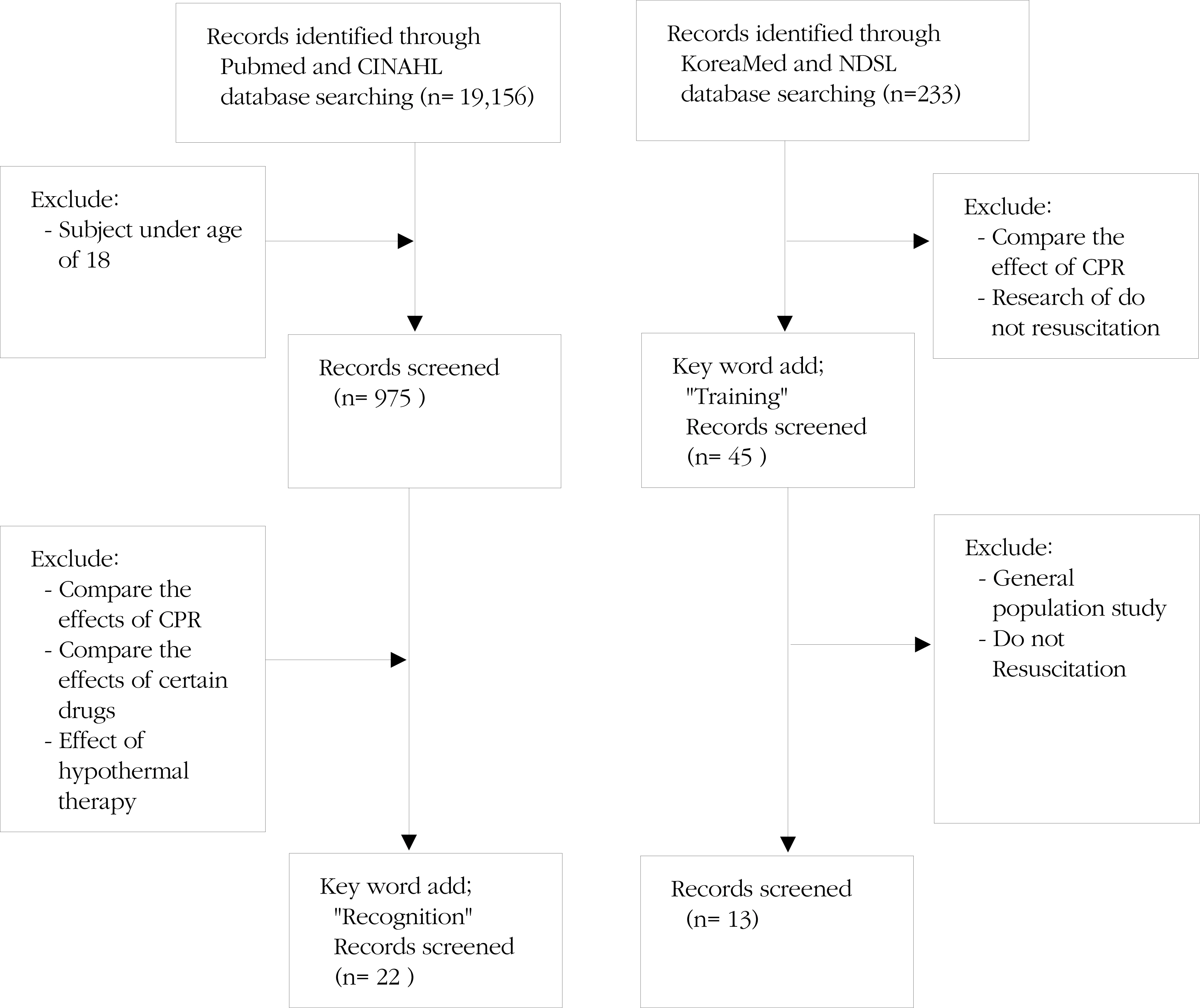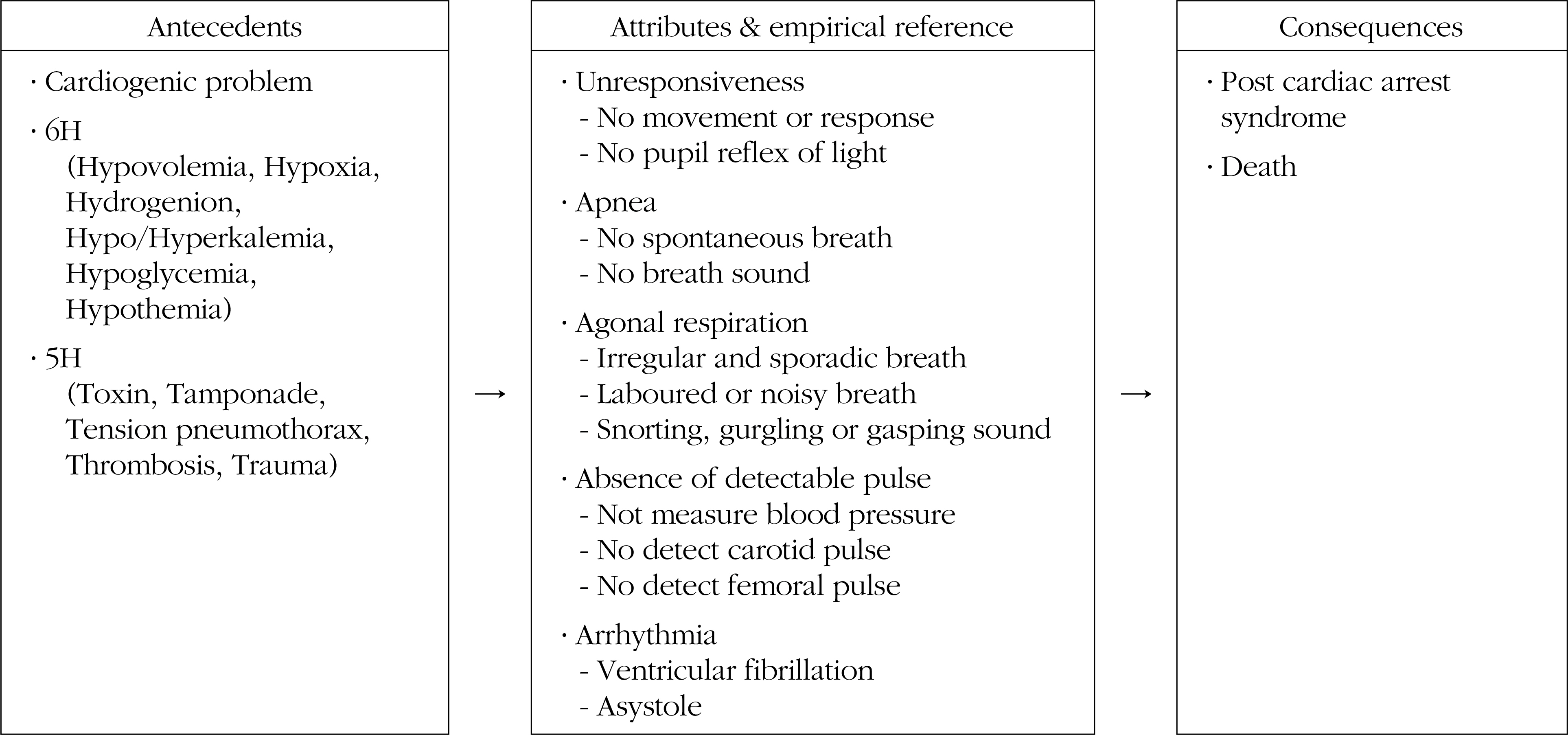1Surgical Intensive Care Unit, Inha University Hospital, Incheon
2Department of Nursing, Inha University, Incheon, Korea
Copyright © 2014 Korean Society of Adult Nursing
This is an Open Access article distributed under the terms of the Creative Commons Attribution Non-Commercial License (http://creativecommons.org/licenses/by-nc/3.0) which permits unrestricted non-commercial use, distribution, and reproduction in any medium, provided the original work is properly cited.



Attributes and Contents of Cardiac Arrest in Literature Review
| Attributes | Researches | Contents |
|---|---|---|
| Unresponsiveness/ unconsciousness | AHA (2010a, 2010c); Cho (2013); Christian, et.al (2011); | ․ Tap the victim's shoulder & shout |
| Jun (2006); Jung & Chung (2010); KACPR (2011); | "Are you all right?" | |
| Kobayashi, et al. (2010); Kwon (2012); Nolan (2011); | ․ No movement or response | |
| On (2006); Ornato (2009); Sandroni, Nolan, Cavallaro, | ||
| & Antonelli (2007); Yu, et al. (2007); | ||
| Apnea | AHA (2010a, 2010c); Cho (2013); Christian, et.al (2011); | ․ Look, listen, and feel |
| Jun (2006); Jung & Chung (2010); Kobayashi, et al | ․ No more than 10 sec to determine | |
| (2010); Kwon (2012); Sandroni, Nolan, Cavallaro, & | ||
| Antonelli (2007); Yu, et al. (2007); | ||
| Agonal respiration | Charles, et al. (2010); Cho (2013); Christian, et. al. | ․ Abnormal breathing |
| (2011); Korea Centers for Disease Control & | ․ Snorting, gurgling or gasping sound | |
| Prevention (2011); Nolan (2011); Nolan, Soar, & | ․ Irregular and sporadic | |
| Perkins (2012); Ornato (2009); | ․ Laboured or noisy breathing | |
| Sandroni, Nolan, Cavallaro, & Antonelli (2007); | ||
| Absence of detectable pulse | AHA (2010a, 2010c); Jung & Chung (2010); Jun (2006); | ․ Carotid pulse detect |
| Kim, Jun, Kim,& Choi (2008); Kobayashi, et al. (2010); | ․ Femoral pulse detect | |
| Kwon (2012); Ruzman, Tot, Ivic, Gulam, Rutman, & | ․ No more than 10 sec to determine | |
| Burazin, (2013); Sandroni, Nolan, Cavallaro, & | ||
| Antonelli (2007); Yu, et al. (2007) | ||
| Arrythmia | AHA (2010a, 2010c); Kim, Lee, Lee, & Kim (2012); | ․ Ventricular fibrillation |
| Korea Centers for Disease Control & Prevention | ․ Pulseless ventricular tachycardia | |
| (2011); Yu, et al. (2007) | ․ Asystole | |
| ․ Pulseless electrical activity |
Attributes of Cardiac Arrest in Field Work
| Attributes | Narrative |
|---|---|
| Unresponsiveness/ unconsciousness | ․ "Suddenly the patient was fell down, and shown no response to verbal stimulation" (Subject 1) |
| ․ "Patient showed no response to verbal stimulation, so I assessed pupil response and found that his pupil was dilated and fixed" (Subject 2) | |
| ․ "The monitor alarm was ringing, and I found that the patient was in unconsciousness state" (Subject 3) | |
| Apnea | ․ "The patient did not breathe, her lips were blue, and saturation level could not be monitored......" (Subject 3) |
| ․ "Because most of ICU patients had ventilator, patients' apnea state might not be obvious for cardiac arrest" (Subject 7) | |
| Absence of detectable pulse | ․ "I could not feel the patient's femoral pulse, so I suspected that cardiac arrest was broken out" (Subject 4) |
| ․ "I think carotid pulse must be palpated to confirm cardiac arrest, but I usually detect pulse from femoral artery" (Subject 5) | |
| Arrhythmia | ․ "EKG monitor alarm was ringing, so I checked monitor and found V-FIB. I immediately started to perform CPR." (Subject 6) |
| ․ "EKG monitor alarm was ringing, and I found V-tac from the screen." (Subject 8) | |
| ․ "If I observed flatness of EKG, I usually made announcement for CPR" (Subject 9) |